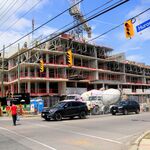Seven Wonders of Canada revealed at CBC.ca
*****
Hume's Seven Wonders list...
Link to article
7 wonders of Canada
It's not the land that has made our country what it is ... it's the way we've shaped it and the things we've built on it, the monumental achievements of engineering and imagination in which we took a wilderness and forged it into a nation - these
Jun 09, 2007 04:30 AM
Christopher Hume
architecture critic
To many, this country is its geography. But to those who know better, what defines Canada is less the land than our response to it. Above all, this means the incredible feats of engineering and construction required just to carve a nation out of the vast northern wilderness, just to enable Canadians to be part of a larger community.
In other words, Canada is its infrastructure and communications are us. No surprise then that any serious debate about the Seven Wonders of Canada would be more focused on human intervention into the topography than the topography itself, no matter how impressive.
Let's start with the transcontinental railway, a heroic accomplishment by any standard, but in the 19th century it was viewed as nothing less than a precondition to nationhood. It was the first of many monumental undertakings needed to connect the disparate regions of a country so dispersed it wouldn't otherwise have made sense.
As Canada's first Prime Minister, John A. Macdonald, put it, "Until this great work is complete, our Dominion is little more than a geographical expression."
The railroad would change all that, and although the builders of the Canadian Pacific Railway experienced their fair share of troubles, it was eventually completed and the rest, as they say, is history.
By contrast, the construction of the Rideau Canal, another of the seven Canadian Wonders, was prompted by military concerns. After the War of 1812 – that's when British troops stationed in Canada burned the White House in Washington – there were fears the Americans would attempt to invade Canada. The idea for the Rideau Canal was promoted by no less a personage than the Duke of Wellington, the man who defeated Napoleon at the Battle of Waterloo.
Built between 1827 and '32, the 202-kilometre long waterway with its 47 locks ran through virgin wilderness. It was constructed out of enormous blocks of stone, quarried at the site whenever possible. Upon completion it immediately became an important commercial route, before being replaced by the St. Lawrence. Now, of course, it is a facility for recreational boating in the summer, the world longest skating rink in winter.
Both the trans-continental railroad and the Rideau Canal would be overtaken by progress. Even the Trans-Canada Highway, which was approved by Parliament in 1948 but not fully finished until 1971, is now more a tourist destination than a major transportation thoroughfare.
Running over 7,000 kilometres, the main highway (the South Route) goes from Victoria. B.C. to St. John's, Nfld. Again, one senses that the motivation for the Trans-Canada was as much emotional as practical; above all, it is the desire to be connected that defines the country.
The St. Lawrence Seaway, on the other hand, still functions much as intended. Built between 1951 and '59, the impressive 3,770-kilometre system was a joint undertaking of Canada and the U.S. It allows ocean-going ships to sail all the way to Lake Superior. The Seaway, which now accommodates recreational uses, was considered the greatest engineering feat in history at the time of its completion.
Then there's the Confederation Bridge, the newest of Canada's Wonders. Extending 12.9 kilometres across the Northumberland Straight, it has joined Prince Edward Island to mainland Canada since it opened in 1997. No surprise Islanders were a little leery of the project, which they feared might somehow compromise their independence.
The "fixed link," as it's known in P.E.I. is the world's longest bridge over ice-covered water. It is also a thing of beauty, a reminder that engineering can be aesthetically pleasing as well as utilitarian.
Technically speaking, the CN Tower, the tallest free-standing structure on the planet, is a communications tower. Nothing could be more Canadian than that. We all know, of course, that it's really an expression of Toronto's edifice complex, not to mention its need for international recognition. Indeed, it has been a symbol of the city since it was completed in 1976.
Designed by Australian-born architect John Andrews (also responsible for the University of Toronto's Scarborough College), the tower ranks among the best such structures in any city. Though the grey concrete shaft has not aged well, it expresses dramatically the mindset of a community intent on proving itself internationally. That the CN Tower has been a success can be seen in the fact that it still manages to attract upwards of two million visitors annually.
Little remains of Expo 67, but the memories have not dimmed over the decades. True, Moshe Safdie's revolutionary Habitat is still occupied, and the old French Pavilion is now a casino, but the significance of Expo went beyond these architectural landmarks. It was the moment, the event, when Canada proved to the world, and more importantly to itself, that it was capable of greatness.
Universal Expositions aren't what they used to be; in the age of the global village, who needs to travel to see the brightest and the best? But back in 1967, the advent of Expo caused excitement across the length and breadth of Canada. Consider that it drew 50 million visitors at a time when the population of Canada was less than half that. Though originally planned for Moscow, the fair coincided with the 100th anniversary of Confederation, an auspicious occasion for a country that still had to define itself. More than any other single event in Canada's domestic history, it was Expo that made Canadians understand the power and potential of the country.
Almost geological in its monumentality, the Citadelle of Quebec is often called the Gibraltar of North America. That's not hard to understand; the most important defensive structure constructed by the English in Canada, it took no less than 30 years to complete. The four-pointed fort was begun in 1820, but earlier fortifications date back to the 18th century.
The 15-hectare installation, adjacent to the Plains of Abraham, remains an active military post to this day. Few sites are more impressive both in their physical presence and historic content. In addition to the role it played in Canada's past, it was where Franklin D. Roosevelt, Winston Churchill and William Lyon Mackenzie King met during World War II.
In typical Canadian fashion, this country's Seven Wonders are much more imposing than they might seem at first glace. Some are so vast – St. Lawrence Seaway and Rideau Canal – they seem almost part of nature. Others, such as the Confederation Bridge take the place of nature. The rest, one way or another, represent various attempts to overcome nature, or at least to render it inhabitable, to make it Canada. Together they constitute the basis of this country; without them civilization would not have been possible.
SEVEN GREAT STRUCTURES THAT MADE A NATION:
1. The Confederation Bridge linking P.E.I. to the mainland
2. The transcontinental railway
3. The Quebec Citadelle
4. Expo 67 in Montreal
5. The Rideau Canal
6. The CN Tower
7. The St. Lawrence Seaway
SOME WONDERFUL ALTERNATIVES:
THE SHRINE of Sainte-Anne de Beaupré, 30 kilomtres east of Quebec City, one of the oldest pilgrimage sites in North America.
THE TOWN of Dawson City, Yukon, centre of the 1896 Gold Rush.
OLD QUEBEC CITY, a UNESCO World Heritage site.
MANITOBA LEGISLATIVE BUILDING, designed by architects Frank Worthington Simon and Henry Boddington III, in Winnipeg.
THE CANADIAN MUSEUM OF CIVILIZATION (designed by Douglas J. Cardinal) in Gatineau, Que.
THE NEW Michael Lee-Chin Crystal (designed by Daniel Libeskind) at Toronto's Royal Ontario Museum.
PEGGY'S COVE, 43 kilometres southwest of Halifax, Nova Scotia.





